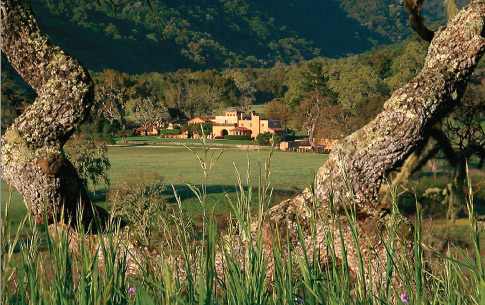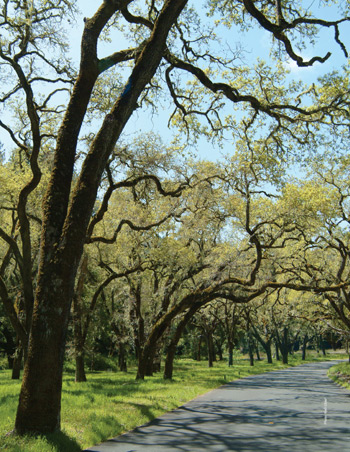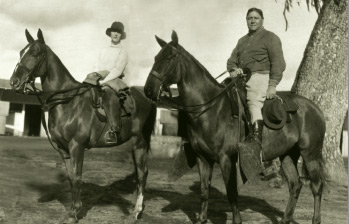
Only a few miles from Highway One off Carmel Valley Road is a portal into another land. The Carmel stone gatehouse on Rancho San Carlos Road that provides access to the Santa Lucia Preserve barely hints at the otherworldly experience up the road. But once through the gate, the transformation becomes obvious. The road may be paved, and there may be houses tucked beneath the tree canopies, but everything else feels very, very wild.
Dark brown pigs lie casually by the side of the road, nursing their young, while some trot into the huge hills above the road, pausing to root for mushrooms. A black baby bobcat peeks out of the underbrush, then darts into some bushes. An eagle flies overhead, then lands on a redwood branch, which sags under its weight.
The expanded sense of scale increases on the eight-mile uphill drive from the gatehouse to the first major landmark: the 1920s-era Spanish Colonial-style Hacienda building. But even the 37-room building, used for dining and to house overnight guests, is dwarfed by the land around it.
The effect is intentional: of the Preserve’s 20,000 acres—or 31 square miles of land—only 2,000 acres are developed. And on those 2,000 acres, only 300 homes are allowed. Visitors to the land are restricted as well: only homeowners, their families and guests, and staff are permitted on the property. An independent nonprofit, known as the Santa Lucia Conservancy, is endowed with $25 million to manage the land. The development plan, which began in 1990, protects riparian areas, archeological areas, redwood groves, and areas that provide habitat for endangered species such as the red-legged frog and Smith’s blue butterfly.
“The open space is preserved in perpetuity,” says Lisa Guthrie, director of clubs and services at the Preserve. “We received awards of merit from the Urban Land Institute and were recognized at the time of development as a new way to preserve land.”
But although the impact of man on nature is designed to be minimal, the people from the past who have enjoyed the land once known as Rancho San Carlos are celebrated.
“We named the rooms at the Hacienda after the different people who have owned the property,” says Guthrie. “They’re all colorful characters. Each of these people and their story marks a period of time in California. This property inspires large living, and these people all kind of reflect that.”
The owners of the ranch, which began as two Mexican land grants, included Don Estévan and Doña Catalina Manzanelli de Munrás in the 1830s, who, according to historian Mark Miller, worked thousands of head of cattle and several hundred horses with the help of vaqueros and Native American laborers.
 In the 1920s, after the land had passed through several other owners, George Gordon Moore turned the ranch into a gentleman’s paradise, complete with polo fields, an artificial lake, and despite Prohibition, wild parties. Guthrie says he filled the Hacienda with Hollywood starlets and champagne and bourbon. He also introduced Russian boars to the land for hunting.
In the 1920s, after the land had passed through several other owners, George Gordon Moore turned the ranch into a gentleman’s paradise, complete with polo fields, an artificial lake, and despite Prohibition, wild parties. Guthrie says he filled the Hacienda with Hollywood starlets and champagne and bourbon. He also introduced Russian boars to the land for hunting.
“You could imagine starlets toodling up the road in old cars,” Guthrie says,“polo was being played and then everyone jumped in their vehicle to clean up and come down to a 1920s party.You can just imagine that house being alive and vibrating with the action and vitality. Moore was rumored to be the actual Gatsby.”
Another room is named for author Robert Louis Stevenson. According to Miller, Stevenson sailed from Scotland to California in 1879 to pursue the hand of a woman in Monterey. Lovesick, ill with tuberculosis, and delirious with fever, Stevenson camped on a goat ranch on Preserve lands. He was found unconscious by a bear hunter and his family, who took him in for several weeks and nursed back to health.
Time doesn’t completely stand still at the Santa Lucia Preserve, but it appears to take on new properties. It feels stretched to include the occupants from the past as well as the lucky few living and playing on the green hills today. One hundred miles of trails provide a walking history lesson, whether traveled on foot or on horseback. Many mornings, Guthrie, who has lived on the Preserve for the past 10 years, rises at dawn to lead a hike. Many evenings, she rides her black Friesian horse named Braeden from the Preserve’s Equestrian Center up the Garzas Canyon. The trail leads past buzzing bees and purple wildflowers along the trout-filled Garzas Creek. The creek flows through the lake named after George Gordon Moore and down into Carmel Valley. As the trail progresses uphill through redwood groves, it winds by the remains of a Rumsen American Indian village. Mussell and abalone shells are exposed in the soil, as are grinding rocks, where Guthrie says the Indians ground acorns into a mash. Areas of dark soil indicate where they cooked acorn patties in hot coals. The trail leads skyward over the “rollercoaster hills” of Hall’s Ridge. At the top are mind-bending views of the mountains and ocean.
That the amenities and structures on the Preserve are so exquisite and yet so lightly used is almost shocking. On an unusually hot Saturday in February, only a few people are using the Preserve’s swimming pool and two-story water slide. Dining at the Hacienda the next day for Sunday brunch, the quiet is amplified by the no-cell phone policy. People speak in low tones or not at all, rustling through the New York Times over eggs Benedict, freshly squeezed orange juice, and perfectly crisp bacon. The view out the window shows a Great Blue heron picking his way through the grasses where polo ponies used to run. The staff greets every guest by name and is instinctively on top of every need:
“Would you like some more Earl Grey tea? I can put it in a cup for you to take with you.”
 The decor is classic: Remington sculptures, plein air art, antique leather-bound books; and yet none-too-serious: a mounted wild boar head grinning on the wall by the front door. The food, prepared by executive chef Carlton Lepine, hits all levels of sensory joy. Fresh, multi-layered, beautifully presented, and lightly delicious, dishes such as a ginger carrot soup topped with fresh crabmeat, or a pulled pork sandwich, are suited to particular seasons.
The decor is classic: Remington sculptures, plein air art, antique leather-bound books; and yet none-too-serious: a mounted wild boar head grinning on the wall by the front door. The food, prepared by executive chef Carlton Lepine, hits all levels of sensory joy. Fresh, multi-layered, beautifully presented, and lightly delicious, dishes such as a ginger carrot soup topped with fresh crabmeat, or a pulled pork sandwich, are suited to particular seasons.
Walking through the Carmel stone, wood, and Spanish tiled golf clubhouse on a foggy morning, there are only two or three people inside, who appear to be staff members. Theroom is seductively inviting: there are plush leather chairs, a massive stone fireplace decorated with a classic frieze, delicate green glass vases and crystal rocks inside Craftsman-style wood cabinets, a polished wood bar, and everywhere are windows out to the land around. Glass jars of jelly beans and homemade chocolate chip cookies sit inside the pristine locker rooms.
The highly rated Tom Fazio golf course is almost hidden into the landscape. Mark Baxter, marketing consultant for the Preserve, has no problem selling homes on the Preserve or memberships to the golf club, which are only offered to homeowners.
“You don’t have to push this on anybody,” he says. “Travel and Leisure Golf voted us the number one golf community last year.We had 9,200 rounds played here last year. That’s nothing. There were more than 70,000 played at Pebble last year.”
The course is rated highly with non-human visitors as well.
“There’s a mountain lion that leaves a kill on the greens most mornings,” says Guthrie. “We haven’t had any problems with him. He’s very well-fed and well-behaved.”
Probably the most noticeable experience at the Preserve is the feeling of leaving everything back in town.There is a Brigadoonish feeling of being in a mystical, time-exempt place that meets every possible need.
“I really find that the days are full and rich,” Guthrie says. “And you really appreciate every moment of the day.”
With so few people, and shared interests of tennis, golf, hiking, horseback riding, or just hanging out, Guthrie says deep friendships develop easily. “There are a lot of spontaneous small dinner parties,” she says. “It’s very casual. There are organized things, but generally, people meet up at the Hacienda in the afternoon and go, ‘Hey, who’s hiking tomorrow?’”
Some of the organized events Guthrie plans for members include a yearly cattle sale and horsemanship exhibition, a plein air artists gathering where members and guests can purchase paintings created on the property by visiting artists, mushroom gathering expeditions, Fourth of July parties, and a Midsummer Night’s Dream opera event in a redwood grove. The latter, Guthrie says, is an almost transcendental experience.
“It’s in a beautiful old redwood grove. It’s this natural open circle,” she says. “There are huge trees above you and you walk up out of creek bed in black tie and we uplight the redwood trees and you are greeted with champagne. On the stage, tucked in its own natural amphitheatre of redwoods, is a baby grand piano with a velvet curtain backdrop. There’s no sound equipment. The only slight sound is the birds. Generally the first half is opera and then the second half is usually American classics. We do a candlelit dinner with wine pairings after the concert.
“Some people had tears in their eyes. A wonderful older gentleman came up to me and said, ‘Thank you. This is one of the most beautiful evenings of my life.’ ”
A book on the history of Santa Lucia Preserve is being written by historian Mark Miller. For more information on the Preserve: 831/626-8200 or www.s